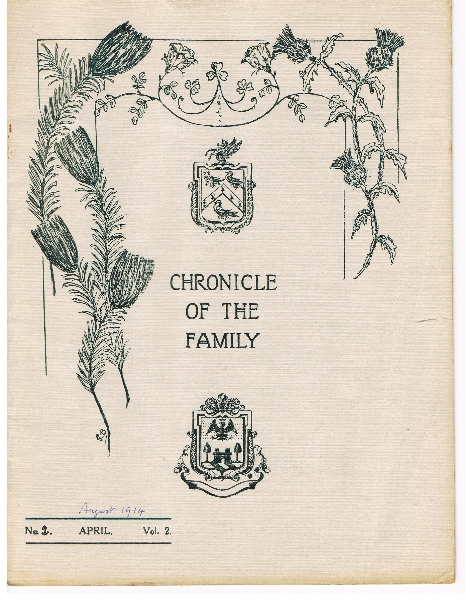
Front Cover — August 1914
Most of this website’s initial selection of stories and recollections were written by members of our family who contributed to a privately printed journal, Chronicle of the Family. This was a remarkable project. In 1912, a quarter of a century after Sir John Charles Molteno had died at Claremont House and less than two years before the First World War broke out, two of his granddaughters – May Murray and Effie Anderson – got together and decided to print a regular journal about the family.
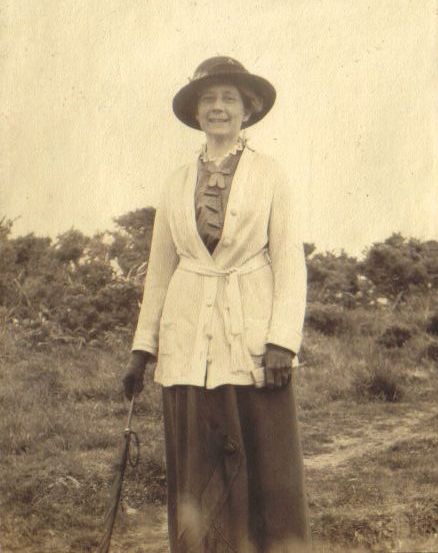
May Murray Parker (June 1916)
For eight years, 1913 to 1920, the Chronicle of the Family was published three times a year. Each issue was 20 or 30 pages long. May and Effie would collect news of family doings, select extracts from letters sent by their relations from other parts of the world, and ask the older generation to write down their recollections of earlier times. The result is a treasure trove of information about the family. A couple of changes occurred in who took the main responsibility for producing the Chronicle. In 1914, Effie (Maria and Tom Anderson’s daughter) got married to Elliot Stanford and went off to live on his farm in the remote region of Griqualand East. She had to drop out as a result. May herself went off in August that year to England where she was hoping to marry Dr Freddie Parker in December. She and Effie announced that they would carry on producing the Chronicle. In fact, what happened was that May’s much younger sister, Kathleen Murray, returned to the Cape in October and took over responsibility. The December 1914 issue still listed May and Effie as the Coeditors, but now with Kathleen as Secretary and another cousin, Brenda Molteno, Frank and Ella’s daughter, as Treasurer. The next issue, April 1915, was edited by Kathleen. It was she and Brenda who kept it going for the next five years until it folded in April 1920.
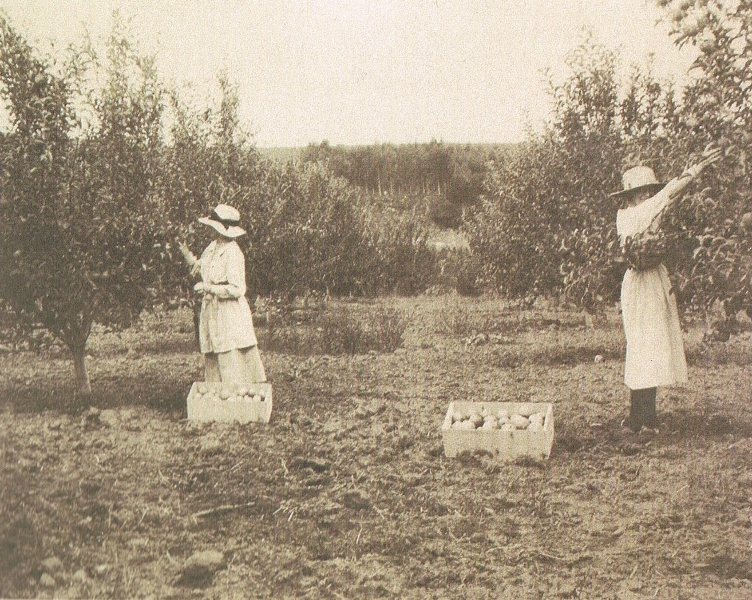
Kathleen Murray at work in her apple orchards shortly after she ceased editing Chronicle of the Family
Why the Chronicle was produced
The reasons for publishing the Chronicle are interesting in themselves. In the Foreword which Kathleen later claimed to have written, three reasons are put forward. First, it would reinforce the informal circulation of letters amongst members of the family. “Many of the communications which now do not ‘go the round’ would ‘charm’ if read and dwelt upon….” Secondly, “this particular family resembles in some respects the famous Banyan Tree, its branches are ever spreading, dipping down and taking root, ever expanding and perchance affording sleep and shelter to weaker fellow mortals who are also fighting the great battle of life. Already its aunts, cousins, brothers and daughters-in-law are fairly numerous; some of them are losing touch with each other, some are scattered abroad, some in Great Britain and others elsewhere…. All are engaged in work, all are agreed that work in some form or other is the most blessed privilege of man — yet it is quite apparent that hardly any two members of the family quite see eye to eye as to the method in which any particular work should be done. This divergency of opinion is not to be deprecated but welcomed, betokening … all are engaged in seeking after that rare jewel, ‘Truth’, the very search for which will contribute to a breadth of view which must in the long run lead to consideration and sympathy for others. Now it seems a great pity that the family influence should not permeate all its members… to convey the record of ‘things attempted, things done’.”
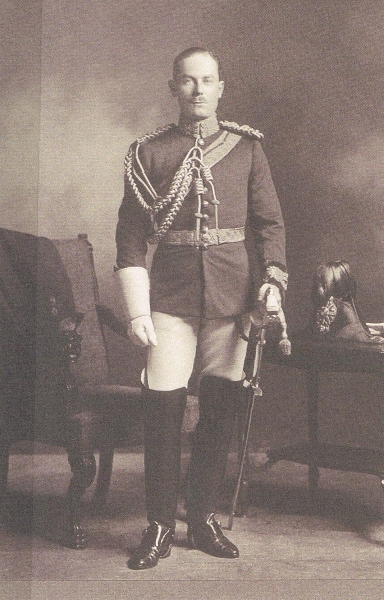
Colonel Ernest Anderson, Medical Officer in the Guards
Certainly it is true that by the time the Chronicle came out, the family was becoming increasingly scattered. Percy Molteno and his family were in Britain, as was his younger brother, Barkly, who was now a full Captain in the Royal Navy. So was their nephew, Vincent Molteno, who was also a Royal Navy officer, albeit often on overseas postings. Their cousin, Dr Ernest Anderson, was a Guards officer; he was posted to France as soon as the First World War broke out. In South Africa, many of the family, notably the four brothers, Charlie, James, Frank and Victor Molteno, and their sister, Caroline Murray, with their families, still lived in the Cape Peninsula. But others were farming 40 miles away in the valley of Elgin (Ted and Harry Molteno, and Kathleen, their niece). Wallace Molteno was raising ostriches and sheep 350 miles off at Nelspoort in the heart of the Karoo. In the even more distant region of East Griqualand on the Natal border, Effie Anderson (now Mrs Elliot Stanford), her brother, Harold Anderson, and cousin, Gordon Murray, were all farming. And more than 2,000 miles further north, the two Murray brothers, Jarvis and Gordon, were trying to set up as farmers in the still very new British colony of Kenya. The third and last reason Kathleen suggested for publishing the Chronicle is one which touches me most. “What is of larger benefit still, it will be the means of preventing the younger members growing up strangers to each other.” A hundred years later, this is precisely why I have initiated this Family Website. You will find some wonderful jewels in the extracts I have taken from the Chronicle. There are Caroline Murray’s recollections of her grandfather’s home (Hercules Jarvis, businessman and former Mayor of Cape Town) at Somerset House in the 1850s and 60s. She also describes the annual month-long wagon trip down from Nelspoort to Cape Town thirty years before the age of the railway. Lil, Wallace’s wife, describes life at Kamferskraal and Nelspoort on the Karoo. From Kenya, Jarvis and Lenox Murray write home about their hunting and land surveying experiences and what happened to them when they joined up to fight the Germans in Tanganyika during World War One.
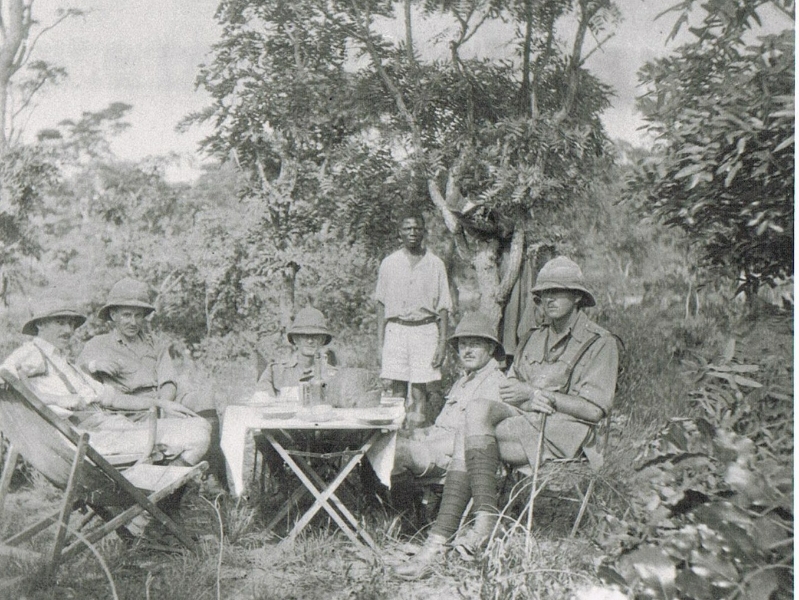
Jarvis Murray in camp near Kasampa during First World War
Their elder brother, Dr Kenah Murray, kept a Diary throughout the War. In it he recorded his experiences in the various theatres where he served – the suppression in 1914 of the Afrikaner Rebellion in the Orange Free State and the Northern Cape against going to war with Germany; South Africa’s invasion and conquest of German South West Africa (today’s Namibia); and finally on the Western Front in France. Ernest Anderson’s letters home describe the terrible suffering of the troops on both sides during the Balkan Wars before 1914 and during the Great War in France. In their diversity, these and all the other accounts give fascinating glimpses of an age few of us today can really imagine.
The Chronicle’s limitation
The big limitation of the Chronicle is that it deals only with Sir John Charles Molteno’s descendants. We learn almost nothing of his own life from the 1830s onwards. Nor is there anything about what happened to his brothers, Frank and Fred, and his sisters, Nancy and Alicia, whom he had left behind in London, and who — except for Nancy who married Mr Bingle and stayed in London — a few years later emigrated to the Sandwich Islands (Hawaii) (Frank went there) and the Australian colonies (Alicia and Fred). Nor, of course, is there anything about the earlier period in the family’s history — the first two generations of Moltenos who settled in London. George Anthony Molteno, our common ancestor, is not really mentioned in the Chronicle (it was he who came from Milan and set up his printselling business in Pall Mall in 1783 – well before the Napoleonic Wars, Catholic emancipation and the Industrial Revolution). Nor do we hear about Anthony’s descendants – his eldest son, James Anthony and his family, who stayed on in London. To find out about these ‘English’ Moltenos – those who by and large never emigrated – we have to look to other sources. But right now, we can only be grateful for the wonderful glimpses, preserved in the Chronicle, of the lives led by our family three generations ago – Moltenos, Murrays, Andersons, Stanfords and others in the 19th and early 20th centuries.
Reading or looking at the whole Chronicle of the Family on this website
The entire Chronicle of the Family has been scanned and put on this website. Each year from 1913 to 1920 constitutes a Volume. Within each year, 1913 to 1918, three Issues were published, dated April, August and December, except that in 1919 and 1920 there was only one Issue in each year. You can read on-screen, or download to your computer, any or all of the 20 Issues. But please note possible sources of confusion in the original printed copies of the Chronicle: one early issue called April on the cover (and April 1913 on the first page) is actually the April 1914 issue; another issue called April No. 2 Vol. 2 is actually the August 1914 issue; and occasionally the running heads within an issue have the wrong date. I have made a Table of Contents which lists the main items to be found in each issue of each annual volume. The way you access any particular issue of the Chronicle is by going to this Table of Contents, and following the link to the particular Issue you want to look at. This scanned version of the Chronicle is, of course, an exact replica of what was printed a century ago. But in addition, I am also gradually transcribing the most interesting stories. For each of these, I am writing a short Introduction, giving each story a title, putting in photographs, and – where necessary – adding explanatory footnotes. To read these transcribed stories, click on List of Stories. Any story that has already been transcribed in this way is highlighted in blue. Click on it and you will get to that story.
